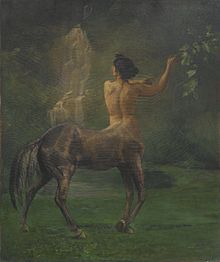Our website is made possible by displaying online advertisements to our visitors.
Please consider supporting us by disabling your ad blocker.
Centaur
 Centauress, by John La Farge | |
| Grouping | Legendary creature |
|---|---|
| Sub grouping | Hybrid |
| Similar entities | Minotaur, satyr, harpy |
| Folklore | Greek |
| Other name(s) | Kentaur, Centaurus, Sagittary[1] |
| Region | Greece, Cyprus |
| Habitat | Land |
A centaur (/ˈsɛntɔːr, ˈsɛntɑːr/ SEN-tor, SEN-tar; Ancient Greek: κένταυρος, romanized: kéntauros; Latin: centaurus), occasionally hippocentaur, also called Ixionidae (Ancient Greek: Ἰξιονίδαι, romanized: Ixionídai, lit. 'sons of Ixion'), is a creature from Greek mythology with the upper body of a human and the lower body and legs of a horse that was said to live in the mountains of Thessaly.[2] In one version of the myth, the centaurs were named after Centaurus, and, through his brother Lapithes, were kin to the legendary tribe of the Lapiths.
Centaurs are thought of in many Greek myths as being as wild as untamed horses, and were said to have inhabited the region of Magnesia and Mount Pelion in Thessaly, the Foloi oak forest in Elis, and the Malean peninsula in southern Laconia. Centaurs are subsequently featured in Roman mythology, and were familiar figures in the medieval bestiary. They remain a staple of modern fantastic literature.
- ^ For Collins English Dictionary: "sagittary." Collins English Dictionary – Complete and Unabridged, 12th Edition 2014. 1991, 1994, 1998, 2000, 2003, 2006, 2007, 2009, 2011, 2014. HarperCollins Publishers September 1, 2019, https://www.thefreedictionary.com/sagittary Archived September 2, 2019, at the Wayback Machine
- ^ "Definition of centaur by Merriam-Webster". merriam-webster.com. Merriam-Webster.com Dictionary. Archived from the original on June 6, 2021. Retrieved June 6, 2021.
Previous Page Next Page


